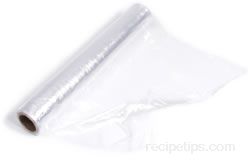 |
|
| A lightweight clear material produced in very thin thicknesses that can be used for covering foods being stored or prepared. The characteristics of this material enable it to shaped easily, cling well to containers, repel or retain moisture, and to withstand relatively high levels of heat when microwaving foods, but not for use in ovens. It is available in various thicknesses that enable it to be used for different needs, such as storing some foods longer or more securely.
Plastic wrap is a good choice for wrapping fresh foods such as sandwiches, and acidic foods, such as fruits, tomatoes, and berries. To keep some fruits from turning brown (apples or avocados) wrap with plastic, pressing the surface of the plastic against the cut and exposed surfaces of the food. Another tip for the use of plastic wrap is to use it for increasing the rate of absorbtion when using a spice rub or dry marinade to season meat. Apply the seasoning and then wrap the meat using two sheets of plastic wrap.
Polyethylene is the most common substance used to make the plastic wraps with several other materials also available from manufacturers, such as polyvinylidene chloride and polyvinyl chloride. |
|
|

